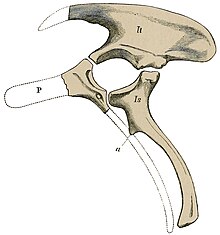Barilium
| Barilium Temporal range: Early Cretaceous,
| |
|---|---|

| |
| Pelvis | |
| Scientific classification | |
| Domain: | Eukaryota |
| Kingdom: | Animalia |
| Phylum: | Chordata |
| Clade: | Dinosauria |
| Clade: | †Ornithischia |
| Clade: | †Neornithischia |
| Clade: | †Ornithopoda |
| Clade: | †Styracosterna |
| Genus: | †Barilium Norman, 2010 |
| Species: | †B. dawsoni
|
| Binomial name | |
| †Barilium dawsoni (Lydekker, 1888 [originally Iguanodon])
| |
| Synonyms | |
| |
Barilium is a genus of iguanodontian dinosaur which was first described as a species of Iguanodon (I. dawsoni) by Richard Lydekker in 1888, the specific epithet honouring the discoverer Charles Dawson, who collected the holotype during the 1880s.[1]

In 2010 it was reclassified as a separate genus by David Norman. The generic name Barilium is derived from Greek barys, "heavy", and Latin ilium.[2] Later in 2010, Kenneth Carpenter and Yusuke Ishida independently assigned it to the new genus Torilion,[3] which is thus a junior objective synonym of Barilium. It is known from two partial skeletons found near St Leonards-on-Sea in East Sussex, England,[4] from the middle Valanginian-age Lower Cretaceous Wadhurst Clay.[5] Lydekker based the species on the syntype series BMNH R798, 798a, 803-805, 806, 798b, 802, 802a and 799-801. Norman chose NHMUK R 798 and R802, a dorsal vertebra and a left ilium, as the lectotype.
A contemporary of Hypselospinus (also once thought to be a species of Iguanodon), Barilium was a robust iguanodontian estimated at 8 metres (26 feet) long.[6]
Barilium is separated from Hypselospinus on the basis of vertebral and pelvic characters, size, and build.[6] For example, Barilium was more robust than Hypselospinus, with large Camptosaurus-like vertebrae featuring short neural spines, whereas Hypselospinus is known for its "long, narrow, and steeply inclined neural spines".[7]
References
[edit]- ^ Lydekker, Richard (1888). "Note on a new Wealden iguanodont and other dinosaurs". Quarterly Journal of the Geological Society of London. 44 (1–4): 46–61. doi:10.1144/GSL.JGS.1888.044.01-04.08. S2CID 129803661.
- ^ Norman, David B. (2010). "A taxonomy of iguanodontians (Dinosauria: Ornithopoda) from the lower Wealden Group (Cretaceous: Valanginian) of southern England" (PDF). Zootaxa. 2489: 47–66. doi:10.11646/zootaxa.2489.1.3.
- ^ Carpenter, K. and Ishida, Y. (2010). "Early and “Middle” Cretaceous Iguanodonts in Time and Space.[permanent dead link]" Journal of Iberian Geology, 36 (2): 145-164.
- ^ Norman, David B. (2004). "Basal Iguanodontia". In Weishampel, D.B.; Dodson, P.; Osmólska, H. (eds.). The Dinosauria (2nd ed.). Berkeley: University of California Press. pp. 413–437. ISBN 978-0-520-24209-8.
- ^ Paul, Gregory S. (2008). "A revised taxonomy of the iguanodont dinosaur genera and species" (PDF). Cretaceous Research. 29 (2): 192–216. doi:10.1016/j.cretres.2007.04.009.
- ^ a b Blows, W. T. (1997). "A review of Lower and middle Cretaceous dinosaurs from England". In Lucas, S.G.; Kirkland, J.I.; Estep, J.W. (eds.). Lower and Middle Cretaceous Terrestrial Ecosystems. New Mexico Museum of Natural History and Science Bulletin, 14. New Mexico Museum of Natural History and Science. pp. 29–38.
- ^ Naish, Darren; Martill, David M. (2008). "Dinosaurs of Great Britain and the role of the Geological Society of London in their discovery: Ornithischia". Journal of the Geological Society, London. 165 (3): 613–623. Bibcode:2008JGSoc.165..613N. doi:10.1144/0016-76492007-154. S2CID 129624992.
| |||||||||||||||||||||||||||||||||||||||||||||||||||
| |||||||||||||||||||||||||||||||||||||||||||||||||||
| |||||||||||||||||||||||||||||||||||||||||||||||||||
| |||||||||||||||||||||||||||||||||||||||||||||||||||
Text is available under the CC BY-SA 4.0 license; additional terms may apply.
Images, videos and audio are available under their respective licenses.








